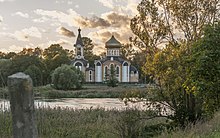Daugavgrīva
Daugavgrīva ( German : Dünamünde ) is a district of the Latvian capital Riga . 9,952 inhabitants (2008) live on an area of 10.147 km². According to the 2011 census, Daugavgriva is the district of Riga with the lowest percentage of ethnic Latvians (22.6%) and the highest percentage of Russians (56.9%). The rest of the population is mainly divided between Belarusians (6.5%) and Ukrainians (6.3%). The total population in 2011 was 9,015.
Location
Daugavgrīva is located in the north-west of the city in the Kurzemes rajons district on the left bank of the Daugava , which flows into the Baltic Sea there. The neighboring districts are Rītabuļļi , Bolderāja , Vecmīlgrāvis and Mangaļsala , with a land border only to Rītabuļļi.
history
In 1205 a Cistercian monastery, the Dünamünde monastery , was donated by Albert von Buxthoeven , which was sold to the Teutonic Order in 1305 . The Dünamünde fortress was built by his knights in 1305 in order to gain political and economic control over the Hanseatic city of Riga. In 1641, during the Swedish rule, it was expanded. In the Great Northern War , Saxon troops took the Dünamünde fortress on March 15, 1700. It was immediately after Augustus II , King of Poland and Elector of Saxony, in Augustusburg renamed. On December 11, 1701, Swedish troops were able to recapture the fortress of Dünamünde. As a result of the Peace of Nystad , Dünamünde fell to the Russian Empire , like all of Livonia .
In 1812 Dünamünde was besieged by Napoleonic troops on the occasion of the Russian campaign under Duke MacDonald for a long period of time, but could not be captured. In the 19th century, Dünamünde was one of the strongest sea fortresses in Europe.
After Latvia gained independence from the Russian Empire, Daugavgrīva was incorporated into the city of Riga in 1924.
During the Second World War, several thousand Jews and concentration camp inmates were murdered by the National Socialist occupiers of Latvia as part of Operation Dünamünde in 1942 . The evacuation of the victims took place on the pretext that they were being taken to work in a canning factory in Daugavgrīva. In fact, they were killed in the Biķernieki forest .
Daugavgrīva was a restricted military area at the time of the Soviet Union. The former barracks still exist today, but they are rarely used.
Daugavgrīva lighthouse has existed in its current form since 1957.
Sons and daughters of the place
- Hermann Witte (1666–1728), German Baltic Evangelical clergyman, Bishop of Åbo
literature
- Hans Feldmann , Heinz von zur Mühlen (Hrsg.): Baltic historical local dictionary, part 2: Latvia (southern Livland and Courland). Böhlau, Cologne 1990, ISBN 3-412-06889-6 , pp. 132-133.
Footnotes
- ↑ Hans Feldmann , Heinz von zur Mühlen (ed.): Baltic historical local dictionary , Volume 2: Latvia (South Livland and Courland). Böhlau, Cologne 1990, ISBN 3-412-06889-6 , p. 132.
- ↑ Hans Feldmann, Heinz von zur Mühlen (ed.): Baltic historical local dictionary, part 2: Latvia (southern Livland and Courland). Böhlau, Cologne 1990, p. 132.
Web links
- City administration information (Latvian)
Coordinates: 57 ° 2 ′ 45 ″ N , 24 ° 2 ′ 21 ″ E



